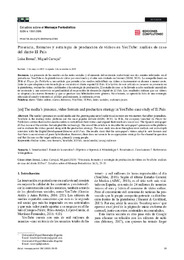Por favor, use este identificador para citar o enlazar este ítem:
https://hdl.handle.net/11000/34339Registro completo de metadatos
| Campo DC | Valor | Lengua/Idioma |
|---|---|---|
| dc.contributor.author | Carvajal, Miguel | - |
| dc.contributor.author | Bernal Montoya, Luisa María | - |
| dc.contributor.other | Departamentos de la UMH::Ciencias Sociales y Humanas | es_ES |
| dc.date.accessioned | 2025-01-11T14:13:11Z | - |
| dc.date.available | 2025-01-11T14:13:11Z | - |
| dc.date.created | 2020 | - |
| dc.identifier.citation | Estudios sobre el Mensaje Periodístico | es_ES |
| dc.identifier.issn | 1988-2696 | - |
| dc.identifier.issn | 1134-1629 | - |
| dc.identifier.uri | https://hdl.handle.net/11000/34339 | - |
| dc.description.abstract | La presencia de los medios en las redes sociales y el aumento del contenido audiovisual son dos asuntos relevantes en el periodismo. YouTube es la plataforma de vídeo por excelencia y el sitio más visitado en Internet (EGM, 2018). La compañía lanzó en 2016 el Player for Publishers, un servicio que permite a los medios redistribuir sus vídeos e incrementar su alcance a menor coste. Entre los que adoptaron esta tecnología se encuentra el diario español El País. El objetivo de este artículo es conocer su presencia en la plataforma, evaluar los vídeos publicados y la estrategia de producción. El estudio de caso se ha llevado a cabo mediante un análisis de contenido y una entrevista en profundidad al responsable de desarrollo digital de El País. Los resultados indican que sus vídeos se adaptan a los nuevos formatos y que se produce una hibridación entre géneros. No obstante, se aprecia la falta de una estrategia adecuada al canal y orientada al público predominante, la audiencia joven. | es_ES |
| dc.description.abstract | The media’s presence on social media and the growing amount of audiovisual content are two matters that affect journalism. YouTube is the leading video platform and the most popular website (EGM, 2018). In 2016, the company launched its Player for Publishers service that enables media outlets to redistribute their videos and expand their reach at a lower cost. The Spanish newspaper El País is one of the entities that adopted this technology. The aim of this article is to describe the newspaper’s presence on the platform and to evaluate the videos posted along with the production strategy. The case study was done through content analysis and an in-depth interview with the Digital Development Director at El País. The results show that the newspaper’s videos adapt to new formats and that there is an existence of genre hybridization. However, there does not seem to be an appropriate strategy for the channel in question and that focuses on the target audience, primarily young people. | es_ES |
| dc.format | application/pdf | es_ES |
| dc.format.extent | 11 | es_ES |
| dc.language.iso | spa | es_ES |
| dc.publisher | Universidad Complutense de Madrid | es_ES |
| dc.relation.ispartofseries | 26 | es_ES |
| dc.relation.ispartofseries | 1 | es_ES |
| dc.rights | info:eu-repo/semantics/openAccess | es_ES |
| dc.rights.uri | http://creativecommons.org/licenses/by-nc-nd/4.0/ | * |
| dc.subject | vídeo online | es_ES |
| dc.subject | nuevos formatos | es_ES |
| dc.subject | YouTube | es_ES |
| dc.subject | El País | es_ES |
| dc.subject | redes sociales | es_ES |
| dc.subject | audiencia joven | es_ES |
| dc.subject | Online video | es_ES |
| dc.subject | new formats | es_ES |
| dc.subject | social media | es_ES |
| dc.subject | young audience | es_ES |
| dc.subject.other | CDU::3 - Ciencias sociales | es_ES |
| dc.title | Presencia, formatos y estrategia de producción de vídeos en YouTube: análisis de caso del diario El País | es_ES |
| dc.type | info:eu-repo/semantics/article | es_ES |
| dc.relation.publisherversion | https://dx.doi.org/10.5209/esmp.67283 | es_ES |

Ver/Abrir:
Bernal y Carvajal - 2020.pdf
868,13 kB
Adobe PDF
Compartir:
 La licencia se describe como: Atribución-NonComercial-NoDerivada 4.0 Internacional.
La licencia se describe como: Atribución-NonComercial-NoDerivada 4.0 Internacional.
.png)